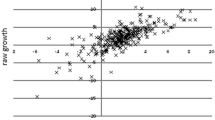Abstract
If voters care about the size of the government's majority, then by-election votes should exaggerate national swings. Moreover, if there is uncertainty about the outcome of the general election and if voters” preferences are skewed in such a way as to give more weight to the “downside” outcome (least favourite party wins) than the “upside” (favoured party wins with a larger than preferred majority), then there will be a systematic tendency for governments to lose by-elections, regardless of any changes in national support. These predictions go beyond those generated by conventional explanations. The theory is successfully tested against data from 383 post-War elections.
Similar content being viewed by others
References
Alesina, A. (1988). Macroeconomics and politics. NBER Macroeconomics Annual. Cambridge, Mass: MIT Press.
Alesina, A. (1990). Evaluating rational partisan business cycle theory: a response. Economics and Politics 5: 1–30.
Alesina, A., Cohen, G. and Roubini, N. (1993). Electoral business cycles in industrial democracies. European Journal of Political Economy 9: 1–23.
Alesina, A. and Rosenthal, H. (1995). Partisan politics, divided government, and the economy. Cambridge: Cambridge University Press.
Backus, D. and Driffill, J. (1985). Inflation and reputation. American Economic Review 75: 530–538.
Barro, R. and Gordon, D. (1983). Rules, discretion, and reputation in a model of monetary policy Journal of Monetary Economics 12: 101–122.
Brennan, G. and Lomasky, L. (1993). Democracy and decision. Cambridge: Cambridge University Press.
Calvert, R. (1985). Robustness of the multidimensional voting model: Candidates motivations, uncertainty and convergence. American Journal of Political Science 29: 69–95.
Downs, A. (1957). An economic theory of democracy. New York: Harper and Row.
Feddersen, T. (1992). A voting model implying Duverger's Law and positive turnout. American Journal of Political Science 36: 982–1062.
Kydland, F. and Prescott, E. (1977). Rules rather than discretion: The inconsistency of optimal plans. Journal of Political Economy 85: 473–490.
Mugham, A. (1986). Towards a political explantion of government vote losses in midterm by-elections. American Political Science Review 80: 761–773.
Mugham, A. (1988). On the by-election vote of governments in Britain. Legislative Studies Quarterly 13: 29–43.
Nannestad, P. and Paldam, M. (1994). The VP-function: a survey of the literature on vote and popularity functions after 25 years. Public Choice 79: 213–245.
Newey, W. and West, K. (1987). A simple positive semi-definite, heteroscedasticity and autocorrelation consistent covariance matrix. Econometrica 55: 703–708.
Norris, P. (1990). British by-elections. Oxford: Clarendon Press.
Paldam, N. (1986). The distribution of election results and the two explanations of the cost of ruling. European Journal of Political Economy 2: 5–24.
Paldam, M. and Skott, P. (1995). A rational-voter explanation of the cost of ruling. Public Choice 83: 159–172.
Persson, T. and Tabellini, G. (1990). Macroeconomic policy, credibility and politics. Chur, Switz.: Harwood Academic Publishers.
Persson, T. and Tabellini, G. (Eds). (1994). Monetary and fiscal policy. Cambridge Mass: MIT Press.
Price, S. and Sanders, D. (1993). Modelling government popularity in postwar Britain. American Journal of Political Science 37: 317–334.
Price, S. (1995). Politics and macroeconomic policy prepared for British Association for the Advance of Science Festival 1995; forthcoming.
Sanders, D. and Price, S. (1996). Disentangling the relationship between party support and perceived economic competence: Some evidence from the UK, 1991 to 1995. Economics Department Discussion Paper City University.
Taylor, S. and Payne, C. (1973). Features of electoral behaviour at by-elections in C Cooke and J Ramsden. By-elections in British politics. London: Macmillan.
Author information
Authors and Affiliations
Rights and permissions
About this article
Cite this article
Price, S., Sanders, D. By-elections, changing fortunes, uncertainty and the mid-term blues. Public Choice 95, 131–148 (1998). https://doi.org/10.1023/A:1004983108916
Issue Date:
DOI: https://doi.org/10.1023/A:1004983108916




